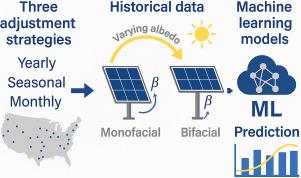基于机器学习的单面和双面光伏系统最佳倾斜角预测
IF 6
2区 工程技术
Q2 ENERGY & FUELS
引用次数: 0
摘要
本研究引入了一种新的基于机器学习的框架,利用来自美国184个地点的6年高分辨率(间隔5分钟)卫星辐照度数据,预测单面和双面光伏系统的最佳倾斜角度。与以前的工作不同,它结合了精细的时间数据,广泛的地理覆盖范围,以及13种机器学习模型的比较评估,以优化三种调整策略下的倾斜角度:年度,季节性和月度。使用各向同性天空模型估计倾斜表面的辐照度,以有效地模拟在反照率范围从0到1的0.1增量范围内的前后侧曝光。所得到的倾斜角度作为模拟的最佳角度,用于训练13个机器学习(ML)模型,使用位置坐标和反照率作为输入特征。模型的准确性在美国15个独立城市得到验证。对于年度预测,高斯核支持向量机(SVMG)和k近邻回归(KNN)分别成为单面和双面系统表现最好的模型,单面和双面的角预测绝对误差分别低于1.0°和1.7°,照射差异可以忽略不计(单面小于0.01%,双面小于0.02%)。进一步的分析表明,双面太阳能板获得的能量很大程度上取决于地面的反射率(反照率),最高可达80%以上,而且太阳能板的最佳朝向会因地点的纬度而发生微妙的变化。所提出的机器学习框架为固定和周期性可调系统中的PV倾斜优化提供了准确、可扩展和计算效率高的解决方案。本文章由计算机程序翻译,如有差异,请以英文原文为准。

Machine learning-based prediction of optimal tilt angles for monofacial and bifacial PV systems
This study introduces a novel machine learning-based framework to predict optimal tilt angles for monofacial and bifacial photovoltaic systems, using six years of high-resolution (5 min interval) satellite irradiance data from 184 U.S. locations. Unlike previous work, it combines fine temporal data, wide geographic coverage, and a comparative evaluation of thirteen machine learning models to optimize tilt angles under three adjustment strategies: yearly, seasonal, and monthly. The irradiance on tilted surfaces was estimated using the isotropic sky model, to efficiently simulate the front- and rear-side exposure across a wide range of albedo values varying from 0 to 1 with 0.1 increments. The resulting tilt angles served as simulated optimal angles for training thirteen machine learning (ML) models using location coordinates and albedo as input features. Model accuracy was validated at 15 independent U.S. cities. For yearly prediction, Support Vector Machine with Gaussian Kernel (SVMG) and k-Nearest Neighbors Regression (KNN) emerged as the top-performing models for monofacial and bifacial systems, respectively, yielding angular prediction absolute errors below 1.0°for monofacial and 1.7°for bifacial, and negligible irradiation discrepancies (less than 0.01% for monofacial and 0.02% for bifacial). Further analysis showed that the amount of energy gained by bifacial panels is strongly dependent on the reflectivity of the ground (albedo), reaching more than 80%, and that the best panel orientation varies in subtle ways depending on the location’s latitude. The proposed ML framework offers an accurate, scalable, and computationally efficient solution for PV tilt optimization in both fixed and periodically adjustable systems.
求助全文
通过发布文献求助,成功后即可免费获取论文全文。
去求助
来源期刊

Solar Energy
工程技术-能源与燃料
CiteScore
13.90
自引率
9.00%
发文量
0
审稿时长
47 days
期刊介绍:
Solar Energy welcomes manuscripts presenting information not previously published in journals on any aspect of solar energy research, development, application, measurement or policy. The term "solar energy" in this context includes the indirect uses such as wind energy and biomass
 求助内容:
求助内容: 应助结果提醒方式:
应助结果提醒方式:


